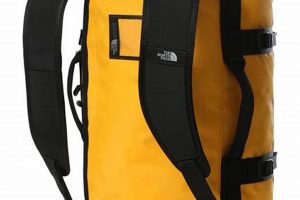The central question addresses the feasibility of cleaning a North Face backpack using a washing machine. This involves assessing the backpack’s materials, construction, and potential damage from machine washing. Considerations include colorfastness, fabric integrity, and the presence of hardware that could be affected by the washing process.
Proper backpack maintenance extends the life of the product and preserves its functionality. While convenience may be a driving factor, understanding the manufacturer’s care instructions is paramount. Historically, hand washing was the standard cleaning method for delicate items, but advancements in washing machine technology have prompted re-evaluation of cleaning practices for various goods.
This analysis will delve into recommended cleaning procedures for North Face backpacks, alternative cleaning methods, and the potential risks and rewards associated with machine washing. It will also explore how to mitigate potential damage and maintain the backpack’s condition.
Cleaning Procedures for North Face Backpacks
Effective backpack cleaning necessitates careful consideration of materials and construction. Adherence to the following guidelines will help maintain the integrity and appearance of the backpack.
Tip 1: Consult the Care Label: Prioritize reviewing the manufacturer’s care instructions attached to the backpack. These instructions provide specific guidance on cleaning methods and suitable products.
Tip 2: Empty and Prepare the Backpack: Remove all items from the backpack. Turn all pockets inside out and shake out any loose debris. Address heavily soiled areas with a soft brush.
Tip 3: Hand Washing as the Preferred Method: Fill a tub or sink with lukewarm water and add a mild detergent specifically designed for delicate fabrics. Submerge the backpack and gently scrub with a soft cloth or sponge.
Tip 4: Machine Washing (If Permitted): If the care label allows machine washing, place the backpack inside a mesh laundry bag to protect it from abrasion. Use a gentle cycle with cold water and a mild detergent. Avoid harsh chemicals or bleach.
Tip 5: Hardware Protection: If the backpack contains metal hardware, consider covering it with cloth or removing it entirely before washing to prevent corrosion or damage to the washing machine.
Tip 6: Thorough Rinsing: Ensure all detergent residue is removed by rinsing the backpack thoroughly under cool, running water. Detergent residue can damage the fabric and attract dirt.
Tip 7: Air Drying: Hang the backpack upside down in a well-ventilated area, away from direct sunlight or heat. Avoid using a machine dryer, as this can damage the fabric and cause shrinkage. Ensure the backpack is completely dry before storing.
Following these procedures will minimize the risk of damage and help maintain the lifespan and functionality of the North Face backpack.
The subsequent sections will explore alternative cleaning methods and address potential challenges associated with backpack maintenance.
1. Material Composition
Material composition fundamentally dictates whether a North Face backpack can withstand machine washing. Different fabrics react variably to water immersion, agitation, and detergents. For instance, backpacks constructed primarily of durable nylon or polyester possess a greater resilience to machine washing compared to those incorporating delicate materials like canvas, leather accents, or specialized waterproof coatings. The integrity of seams, stitching, and internal reinforcements also hinges on material quality; weaker materials are more prone to damage during the wash cycle.
The type of waterproof treatment applied to the fabric significantly impacts washability. Durable Water Repellent (DWR) finishes, commonly used in North Face backpacks, can degrade with excessive washing, especially when exposed to heat or harsh detergents. Machine washing, even on a gentle cycle, can accelerate the breakdown of these coatings, reducing the backpack’s water resistance. Therefore, understanding the specific materials and treatments used in a particular North Face backpack is crucial before attempting to machine wash it. Examples include the Base Camp Duffel fabric, a laminated material thats generally more robust, versus lighter-weight pack fabrics designed for minimal weight, which may be more susceptible to abrasion during machine washing.
In summary, the backpack’s material composition is a primary determinant of its suitability for machine washing. Assessing the fabric type, seam construction, and the presence of any water-resistant treatments provides valuable insight into potential risks. While some materials can withstand the rigors of a washing machine, others necessitate alternative cleaning methods to prevent damage and prolong the backpack’s lifespan. Failure to account for material composition could result in premature wear, loss of water resistance, or irreversible damage to the backpack.
2. Care Label Instructions
Care label instructions represent the manufacturer’s recommended approach to cleaning, directly influencing the decision of whether a North Face backpack can be safely placed in a washing machine. The care label provides crucial guidance regarding appropriate washing methods, water temperature, detergent types, and drying procedures. Deviation from these instructions can result in damage, including fabric degradation, color fading, or structural compromise. For example, a care label might explicitly state “Hand Wash Only,” precluding machine washing entirely. Conversely, it might permit machine washing on a gentle cycle with cold water, indicating a degree of washability. In cases where the care label is absent or illegible, erring on the side of caution by opting for hand washing is advisable.
The significance of care label instructions stems from the manufacturer’s intimate knowledge of the backpack’s construction and materials. They have likely tested various cleaning methods to determine the optimal approach for maintaining the product’s integrity. Ignoring these instructions poses a risk of invalidating warranties or causing irreversible damage. Consider a backpack with a specialized waterproof coating; the care label might caution against using harsh detergents or high temperatures, as these can strip the coating and compromise its functionality. A backpack’s longevity is intrinsically linked to adherence to the care label’s guidance. Real-life consequences of disregarding care labels range from minor cosmetic damage to complete product failure.
In conclusion, care label instructions serve as a primary determinant in answering the question of whether a North Face backpack can be machine washed. Compliance with these instructions is essential for preserving the backpack’s condition and extending its lifespan. The practical significance lies in avoiding costly damage and maintaining the product’s functionality as intended by the manufacturer. The information contained on the care label should override assumptions or generalizations about the washability of similar products, underscoring the importance of consulting this resource before initiating any cleaning process.
3. Hardware Durability
Hardware durability, encompassing zippers, buckles, and frame components, directly influences the feasibility of washing a North Face backpack in a washing machine. The integrity of these elements under the mechanical stress and chemical exposure inherent in machine washing determines the backpack’s post-wash functionality. Corrosion, breakage, or deformation of hardware can render the backpack unusable or significantly reduce its lifespan. For example, a zipper constructed from a lower-grade metal alloy is susceptible to corrosion when exposed to detergents and prolonged water immersion. Similarly, plastic buckles may become brittle and prone to fracture after repeated wash cycles, particularly if subjected to high temperatures. Internal frame components, if present, may shift or warp, altering the backpack’s shape and load-bearing capacity. Therefore, the composition and construction of the hardware are critical factors in assessing the suitability of machine washing. If hardware components are flimsy or appear susceptible to damage, hand washing is generally the preferred cleaning method.
Addressing the vulnerability of hardware requires proactive measures. Prior to machine washing, all pockets should be emptied to prevent obstructions and undue stress on zippers. Protecting hardware with cloth or mesh bags can mitigate direct abrasion during the wash cycle. Furthermore, selecting a mild detergent formulated for delicate fabrics minimizes the risk of corrosion or chemical degradation. The drying process is equally important; prolonged exposure to direct sunlight or high heat can accelerate hardware damage. Thoroughly drying all hardware components after washing is crucial to prevent rust or mildew formation. Consider the example of a backpack used frequently in marine environments; salt residue can exacerbate corrosion, necessitating meticulous cleaning and drying of all metal components. Ultimately, careful attention to hardware protection significantly extends the backpack’s usable life, irrespective of the chosen cleaning method.
In conclusion, the durability of a North Face backpack’s hardware components is inextricably linked to the decision of whether machine washing is a viable cleaning option. The potential for damage to zippers, buckles, and frame elements necessitates a careful evaluation of material composition and construction. Implementing protective measures during the wash cycle, selecting appropriate detergents, and ensuring thorough drying are essential for preserving hardware integrity. While some robust hardware may withstand machine washing with minimal risk, delicate or corrosion-prone components require the gentler approach of hand washing. The long-term functionality and aesthetic appeal of the backpack depend on a comprehensive understanding of the interplay between cleaning methods and hardware durability.
4. Washing Machine Settings
The selection of appropriate washing machine settings is paramount in determining the safety and efficacy of cleaning a North Face backpack within a machine. Incorrect settings can lead to fabric damage, hardware malfunction, and a reduction in the backpack’s overall lifespan. Careful consideration of these settings is essential to mitigating risk.
- Cycle Selection: Gentle Cycle
The gentle cycle utilizes a slower agitation speed and shorter wash time compared to standard or heavy-duty cycles. This reduced mechanical stress minimizes the risk of tearing or stretching delicate fabrics and prevents excessive abrasion of seams and stitching. Utilizing this setting is especially critical for backpacks with lightweight materials or intricate designs that are more vulnerable to damage. Real-world applications show that employing a heavy-duty cycle on a backpack with a DWR finish can prematurely degrade the water repellency of the fabric.
- Water Temperature: Cold Water
Cold water washing helps preserve the colorfastness of the backpack fabric and prevents shrinkage or distortion. High water temperatures can damage synthetic fibers and weaken adhesives used in construction. Furthermore, cold water minimizes the leaching of dyes, which can stain other items in the wash. The use of hot water is particularly detrimental to backpacks with waterproof membranes, as it can compromise their integrity and reduce their effectiveness.
- Spin Speed: Low or No Spin
High spin speeds exert significant centrifugal force on the backpack, potentially causing damage to zippers, buckles, and internal frame components. Opting for a low spin speed or disabling the spin cycle altogether reduces the risk of these issues. Excess water can be gently pressed out manually before air drying. In field tests, high spin speeds have been shown to bend or break plastic buckles, rendering the backpack unusable.
- Water Level: High Water Level
A high water level ensures the backpack is fully submerged and allows for adequate rinsing of detergent residue. Insufficient water levels can result in concentrated detergent exposure, leading to fabric damage or discoloration. Additionally, a high water level reduces friction between the backpack and the washing machine drum, minimizing abrasion. This is especially important for backpacks with delicate or textured surfaces that are prone to snagging or pilling.
In summary, the careful selection of washing machine settings encompassing cycle, temperature, spin speed, and water level directly influences the outcome of cleaning a North Face backpack in a washing machine. Employing gentle settings minimizes mechanical stress and chemical exposure, thereby reducing the risk of damage and extending the backpack’s lifespan. By adhering to these guidelines, individuals can safely and effectively clean their backpacks while preserving their functionality and aesthetic appeal.
5. Detergent Selection
The choice of detergent is critical when considering machine washing a North Face backpack. The detergent’s chemical properties interact directly with the backpack’s materials, potentially influencing its longevity and performance.
- pH Level and Fabric Integrity
Detergents with extreme pH levels, either highly acidic or alkaline, can degrade fabric fibers. Mild detergents, formulated with a neutral pH, minimize this risk. Harsh chemicals can weaken the fabric, leading to premature wear and tear, particularly in stress points such as seams and straps. Examples include detergents containing bleach, which can cause discoloration and fiber breakdown, making the backpack more susceptible to tearing. The implications within the context of washing a North Face backpack are significant, as the materials are often treated with water-repellent coatings which can be damaged by harsh detergents.
- Enzymes and Material Compatibility
Enzyme-based detergents, designed to break down organic stains, can damage certain synthetic materials. While effective for removing dirt and grime, these enzymes can attack the polymers in nylon or polyester fabrics, compromising their structural integrity. Backpacks with specialized coatings or laminated layers are particularly vulnerable. Consider a scenario where an enzyme-based detergent degrades the waterproof membrane of a North Face backpack, rendering it less effective in wet conditions. Selecting detergents specifically formulated for delicate fabrics minimizes this risk.
- Residue and Performance Fabrics
Detergent residue left in the fabric after washing can attract dirt and reduce the breathability of performance fabrics. Backpacks constructed with breathable mesh or moisture-wicking materials are particularly susceptible to this issue. Residual detergent can clog the pores in these fabrics, diminishing their effectiveness. Rinsing the backpack thoroughly after washing is essential to remove any lingering detergent. Failure to do so can negate the benefits of the performance materials, making the backpack less comfortable and functional, especially during strenuous activities.
- Scent and Allergens
Highly scented detergents can leave residual fragrances that may irritate sensitive skin or trigger allergic reactions. Individuals with allergies or sensitivities should opt for fragrance-free detergents. Moreover, the chemicals used to create these scents can potentially interact with the backpack’s materials, causing discoloration or degradation. Selecting a hypoallergenic and fragrance-free detergent minimizes the risk of adverse reactions and protects the backpack’s integrity. The impact is most pronounced for those who carry the backpack directly against their skin for extended periods.
The relationship between detergent selection and the viability of machine washing a North Face backpack is clear. Using an inappropriate detergent can compromise the backpack’s materials, diminish its performance, and potentially shorten its lifespan. Thoughtful detergent selection, prioritizing mild, pH-neutral, enzyme-free, and fragrance-free options, is essential to maintaining the backpack’s integrity and functionality when machine washing is deemed appropriate.
6. Drying Process
The drying process following a wash cycle, whether by hand or machine, is a critical determinant of a North Face backpack’s longevity and performance. Improper drying techniques can negate the benefits of careful washing, leading to material degradation, mold growth, or hardware damage.
- Air Drying vs. Machine Drying
Air drying is the generally recommended method for drying North Face backpacks after washing. Machine drying, even on low heat, can cause shrinkage, warping, and damage to delicate fabrics or water-resistant coatings. The high temperatures can also melt adhesives used in the backpack’s construction. Air drying allows for gradual moisture evaporation, minimizing stress on the materials. A real-world example involves a North Face backpack with a DWR finish; machine drying can significantly reduce the effectiveness of this coating, compromising the backpack’s water resistance. Air drying is a gentle alternative that preserves the backpack’s integrity.
- Sunlight Exposure
Direct sunlight can fade or discolor the backpack’s fabric, especially darker colors. Prolonged exposure to UV radiation can also weaken synthetic fibers. Drying the backpack in a shaded or well-ventilated area protects its appearance and structural integrity. This is particularly relevant for backpacks used frequently outdoors, where sun exposure is already a factor. Consider a black North Face backpack left in direct sunlight; the fabric is likely to fade and become brittle over time. A shaded drying area mitigates these risks.
- Proper Ventilation
Adequate ventilation is essential to prevent mold and mildew growth. Backpacks should be hung upside down with all pockets open to facilitate air circulation. Ensuring that all interior compartments are thoroughly dried prevents moisture from becoming trapped, which can lead to unpleasant odors and material degradation. A backpack stored in a damp environment is prone to mold growth, which can damage the fabric and render the backpack unusable. Proper ventilation ensures complete drying and prevents these issues.
- Hardware Corrosion
Hardware components, such as zippers and buckles, are susceptible to corrosion if not dried properly. Residual moisture can cause rust or oxidation, compromising their functionality. Thoroughly drying all hardware after washing is crucial to maintaining their performance. This is especially important for backpacks used in humid or marine environments, where corrosion is accelerated. A corroded zipper can be difficult to open or close, reducing the backpack’s overall utility. Proper drying of hardware prevents these problems.
The drying process, therefore, is an integral part of the cleaning regimen for a North Face backpack. While machine washing may be appropriate in some cases, proper drying techniques are universally applicable and essential for preserving the backpack’s condition and extending its lifespan. Ignoring these considerations can undo the benefits of careful washing, leading to avoidable damage and reduced functionality.
Frequently Asked Questions
The following addresses common inquiries regarding the suitability and methods for cleaning North Face backpacks.
Question 1: Is it generally permissible to machine wash a North Face backpack?
The permissibility of machine washing a North Face backpack is contingent upon the material composition, construction, and the manufacturer’s care instructions. Consultation of the care label is paramount. Backpacks constructed of durable nylon or polyester may withstand a gentle cycle, while those with delicate materials or intricate details require hand washing.
Question 2: What washing machine settings are optimal for cleaning a North Face backpack?
If machine washing is deemed appropriate, the use of a gentle cycle with cold water is recommended. A low or no spin cycle minimizes stress on the backpack’s components. High water levels ensure thorough rinsing and reduce abrasion.
Question 3: Which detergents are best suited for washing a North Face backpack?
Mild detergents, specifically formulated for delicate fabrics, are preferred. Detergents with a neutral pH minimize the risk of damage to the fabric and water-resistant coatings. Enzyme-based detergents should be avoided, as they can degrade certain synthetic materials.
Question 4: How should a North Face backpack be dried after washing?
Air drying is the recommended method. The backpack should be hung upside down in a shaded, well-ventilated area. Machine drying can cause shrinkage and damage to the fabric. Thoroughly drying all hardware components is crucial to prevent corrosion.
Question 5: Can machine washing damage the water-resistant coating on a North Face backpack?
Yes, machine washing, particularly with harsh detergents or high heat, can degrade the durable water repellent (DWR) finish on a North Face backpack, reducing its water resistance. Following the care label instructions and using appropriate detergents can minimize this risk.
Question 6: What are the potential consequences of disregarding care label instructions?
Disregarding care label instructions can result in fabric damage, color fading, hardware malfunction, and a reduction in the backpack’s lifespan. Furthermore, it may void any warranties associated with the product.
In summary, careful consideration of material composition, washing machine settings, detergent selection, and drying methods is essential when cleaning a North Face backpack. Adherence to care label instructions is paramount in preserving the backpack’s integrity and functionality.
The subsequent section will explore alternative cleaning methods.
Conclusion
The inquiry of “can you put a North Face backpack in the washer” necessitates a nuanced response, dependent on multiple factors. Examination of material composition, adherence to care label instructions, assessment of hardware durability, judicious selection of washing machine settings, and a comprehensive understanding of drying processes are all crucial determinants. A blanket endorsement of machine washing is inadvisable, as inappropriate application can lead to irreversible damage and diminished functionality.
Responsible ownership of a North Face backpack mandates a commitment to informed maintenance practices. While convenience may be a tempting justification for disregarding recommended cleaning protocols, the long-term integrity of the product hinges on diligent adherence to established guidelines. By prioritizing preservation over expediency, users can ensure the continued utility and longevity of their equipment, thereby maximizing their investment and minimizing unnecessary waste.






![The Ultimate All Black North Face Backpack [Review] Ultimate Backpack Traveler Guide: Tips, Destinations & Budget Hacks The Ultimate All Black North Face Backpack [Review] | Ultimate Backpack Traveler Guide: Tips, Destinations & Budget Hacks](https://backpack-traveler.com/wp-content/uploads/2025/11/th-748-300x200.jpg)
